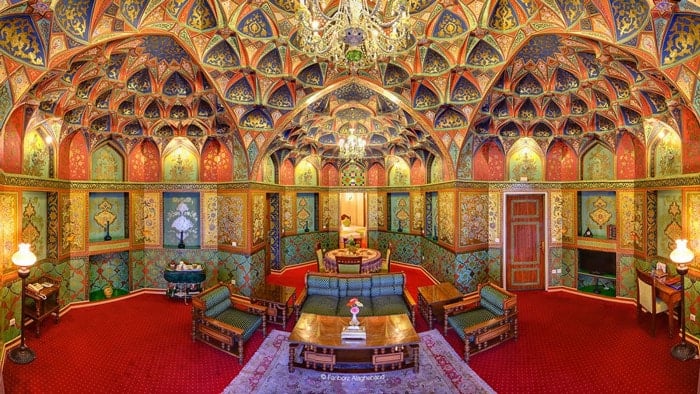Shahrestan Bridge, Isfahan’s Most Ancient Bridge
Hidden Beauty of Shahrestan Bridge in Isfahan

The city of Isfahan has many attributes that justifies its being one of Iran’s most visited cities, as it’s one of the best places to discover the greatness of Persian history, architecture, and culture. Besides the beauty of Naqshe Jahan Square, Isfahan is also famous for being the city of bridges. Eleven of them are crossing the Zayandeh Rud, a 400-kilometers river that flows from the Zagros mountains to the south of Isfahan and that gave life to Isfahan and many villages around.
If Sie-o-Se Pol, Khaju Bridge and Marnan Bridge are among the most famous, Shahrestan Bridge is yet another important sight. This bridge is indeed the oldest of the eleven bridges of the Zayandeh Rud: Built under the Sassanid Empire, it is about 14 centuries old.
Nowadays, because of the redirection of the Zayandeh Rud, the river flow no longer passes under Shahrestan Bridge. Yet an artificial lake has been kept all around it to protect the bridge from damages. Shahrestan Bridge, which can translate to City Bridge, is located in the east of Isfahan, was also named “Jay Bridge” in the past, as Isfahan was known under this name in ancient times.
Contents
History of Shahrestan Bridge in Isfahan

The foundations of Shahrestan Bridge date back from the Sassanid Empire, which ruled over Persia between the 3rd and the 7th century. It was built near an ancient hill named Ashraf. This bridge was the first to be built over the Zayandeh Rud and the only historical bridge of Isfahan that was built before the Safavid Era. It remained the only bridge in Isfahan during the Buyid (10th century) and Seljuk Empires (11 century) and was renovated several times by the kings of these empires.
Shahrestan Bridge may have been originally built for military purposes, such as Dezful and Shushtar’s ancient bridges. As it allowed the passage of caravans as well as pedestrians, the bridge was used frequently by people commuting between Isfahan and the southern villages. For that reason, a tollhouse, the Rahdar Khaneh, was built at the northern end of the bridge and remains today. Built in adobe and clay, the Rahdar Khaneh was used to monitor the entry and exit of caravans and passengers.
Architecture of Shahrestan Bridge in Isfahan

While most historical places in Isfahan bear the footprint of the Safavid Empire, Shahrestan Bridge’s architectural style perfectly embodies the Sasanian style. The bridge was built on a narrower part of the Zayandeh Rud, to help make the bridge more stable. It measures 107.8 meters long and 5.2 meters wide in average.
Shahrestan Bridge has a two-level arches structure: 13 on the bottom and 8 on the top. The bridge’s foundations, which count 12 large stone foundations and 11 waterspouts, were laid directly on the natural stones of the river bed.
The bridge also has an interesting two parabolas structures. Because of the vertical parabolic structure, the middle point of the bridge is higher than the rest of the bridge, which contributes to taking away the pressure of the passing of caravans. The horizontal parabolic structure creates a bend to the west side of the bridge to make it more resistant to the river flow.
Eventually, there are several structures called “Kaneh”, which are a hollow part, also designed to reduce the weight of the structure and make the bridge more resistant. The whole structure was thus designed to fasten the passage of water, so that pressure would be taken away from the bridge during flood.
Visit Shahrestan Bridge in Isfahan

While less famous than Sie-o Se Pol and Khaju Bridge, Shahrestan Bridge is worth the visit for its historical importance. It was inscribed indeed on Iran’s National Heritage List in 1970 and can be visited for free.
The bridge is located in the old Jay neighborhood, on the east of the city. The best way to reach Shahrestan Bridge, located about 7 kilometers south of Naqshe Jahan is by taxi. There is also a bus station nearby.
- Address: Salman Farsi Street, Bozorgmehr Square, Isfahan
- See the location on Google Maps
Nearby Attractions to Shahrestan Bridge in Isfahan

Shahrestan Bridge is located in the southeastern part of Isfahan, outside of the historical city center. Even though there are a few historical and touristic sights nearby. Shahrestan Bridge is, for instance, located at a short distance from Al-Rashid Mausoleum. It is also located 850 meters away from Ashraf Historical Hill and Mehrbin Fortress, which are archaeological remains related to the Parthian and Sassanid Eras.
Hotels Near Shahrestan Bridge in Isfahan
Shahrestan Bridge is located in the southeast part of Isfahan, which is not the most convenient location to choose a hotel for a short visit of the city. Yet, it is not that far from the historical center and Naqshe Jahan, which can be reached in about 15 minutes by taxi. If you’re looking for a hotel at a short distance from Shahrestan Bridge, we can recommend the following:
- Khajoo Hotel
- Parsian Kowsar Hotel
- Espadan Hotel





